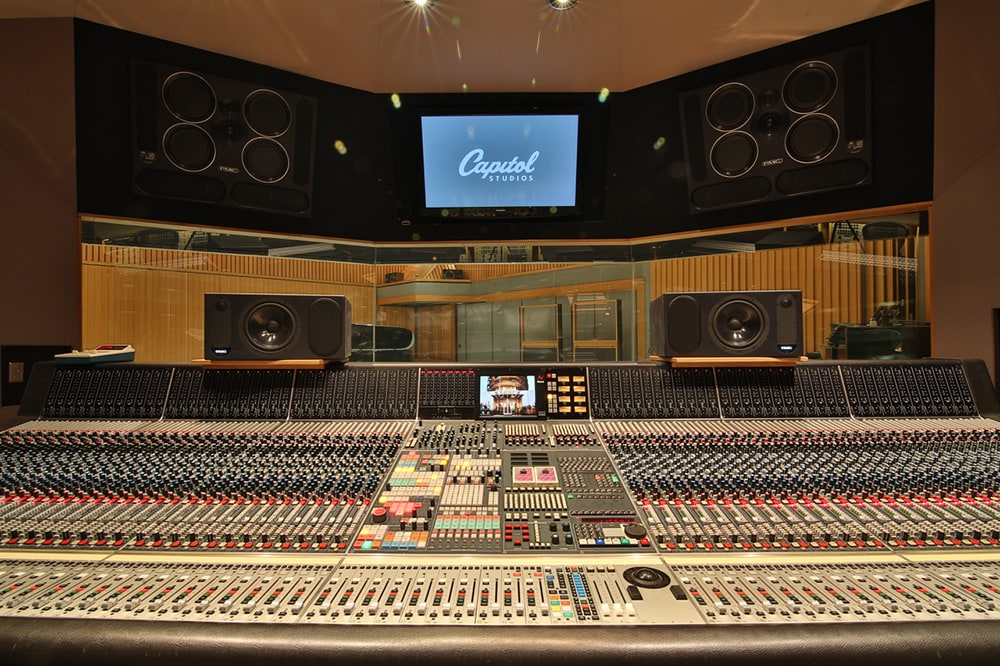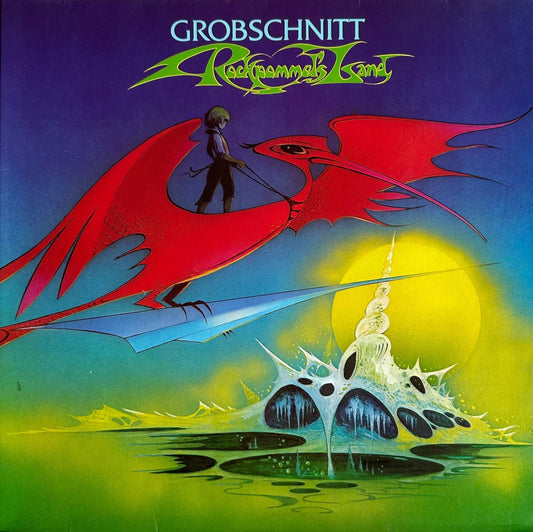“7 Audio Wonders of the World” was a series of virtual recording studio tours created by the Audio Engineering Society (AES) as the star attraction for its AES Fall Show 2020, conducted online this year due to COVID-19 restrictions. Copper issues 123 – 133 covered Skywalker Sound, Galaxy Studios, The Village, Blackbird Studio, Abbey Road Studios and United Recording Studios. This issue includes Capitol Studios.
Capitol Studios on Hollywood and Vine Street is probably the most recognizable building among these iconic studios, thanks to its cylindrical architecture and signature spire overlooking Los Angeles.

The Capitol Records building. Courtesy of Wikimedia Commons/downtowngal.
When a film or TV show wishes to signify New York as a location, the associations with the Empire State Building, Brooklyn Bridge and the Statue of Liberty immediately come to mind. For Los Angeles, the immediate locale signifiers are: The “Hollywood” Hills sign, beaches and palm trees, and The Capitol Records Tower.
Brian Kehew, co-author of Recording the Beatles, hosted the AES virtual tour, supplemented with some samples from over 46,000 archived photos that document Capitol’s history.
Originally located on Melrose Ave., Capitol Records hired architect Welton Becket for expansion of its offices and recording facilities in 1954. Becket was already renowned for designing the Cinerama Dome movie theater, Santa Monica Civic Auditorium, and his hand in helping to design the LAX Airport Theme Building, with its “space age” motif.
Capitol Studios’ grand opening was on April 6, 1956, at a final cost of two million dollars. The Capitol Tower roof loomed 150 feet high over Vine Street, and its unmistakable spire, originally intended as a radio broadcast antenna, stretched a further 90 feet into the skies. The building’s unique cylindrical design was intended to maximize floor space and minimize interoffice foot travel distances. Originally, Capitol thought it looked too much like a 45 RPM record stack gimmick and wanted a rectangular building, but its insurance company preferred the cylinder design and prevailed.

Studio A. Courtesy of Capitol Records.
Frank Sinatra was Capitol’s biggest star in the 1950s, and the studio’s first artist to record there, along with Nat “King” Cole (Capitol Studios was often referred to as “The House that Nat Built” due to his huge popularity and record sales). Perhaps because of his stellar vocals, Nat “King” Cole’s keyboard playing has been often overlooked, but his favorite Hammond B3 organ and Steinway grand piano are still in use at Capitol Studios.
Capitol has mics dating from the 1940s to the present. They have a huge Neumann U47 and RCA 44 collection in particular and they still have Frank Sinatra’s preferred U47 in a special box marked, “Frank.”

Nat “King” Cole, Unforgettable.
Other recording artists during Capitol’s early years include Gene Vincent and the Blue Caps, The Beach Boys (“Surfin’ USA” was cut in Studio B), the Kingston Trio, Wanda Jackson and Buck Owens.
The virtual tour included a visit with Paula Salvatore, Vice President of Client Relations and Studio Marketing, UMG, who was lauded by Tom Petty in the documentary Sound City. Her special guest was fabled producer and engineer Al Schmitt, recipient of over 160 gold and platinum albums and 23 Grammy awards. Sadly, Schmitt passed away in April 2021. He spoke about a number of noteworthy projects produced at Capitol, such as George Benson’s triple-platinum Breezin’. Paula was Al’s “studio wife” because he spent so much time at Capitol. Schmitt gushed about how he loved the sound of the rooms, the microphone collection and the working environment, and talked about why Capitol has what he considered to be the best assistants and maintenance staff in the world.

Frank SInatra, Nice “N” Easy.
Studio A
Studio A is a large, 1,500-square-foot recording space. It is separated from Studio B by retractable soundproof walls, which effectively allow for both rooms to be combined upon demand. The monitor speakers are PMC QB1-As.

Studio A. Courtesy of Capitol Studios.
Considered by many in the audio industry as one of the finest-sounding orchestral recording rooms on the planet, Studio A can easily seat 50 musicians. Adjustable wooden panels on the walls are designed to adjust the reverberation delay time in the room. Two isolation booths, one smaller and one larger, also have adjustable acoustic panels.
Tommy Vicari, who started his career at Capitol in the mailroom, has been an engineer since the 1970s when George Benson cut “This Masquerade” with Al Schmitt. As someone who has engineered solo artists, rock groups, big bands, film/TV scores, the Academy Awards simulcasts, and pre-recordings for the Super Bowl, VIcari believes Capitol’s Studio A is the most complete room for production in the industry.
Studio A’s analog console is a Neve 88RS with 72 inputs, running Pro Tools HDX. The studio features 7.1 surround-sound mixing and monitoring via PMC QB1-A speakers.
The studio’s outboard equipment includes Fairchild 670 and UREI 1176 vintage compressors, Summit Audio equalizers, vintage and modern DBX and Lexicon processors and additional gear, all housed in a humongous patch bay. Artists who have recorded in Studio A lately include Sam Smith, Muse, Imagine Dragons, Billie Eilish, Ariana Grande and Katy Perry.

The Studio A live room looking into the Studio B live room. Courtesy of Capitol Studios.
Studio B
Studio B’s maiden project was Frank Sinatra’s 1956 Tone Poems of Color, containing orchestrations which Ol’ Blue Eyes himself conducted. With over 1,000 square feet, Studio B is a favorite of rock musicians, especially for its 150 square foot drum booth, and it can also accommodate large ensembles. Landmark rock records recorded in Studio B include The Band (“I Shall Be Released”) and The Joker by the Steve Miller Band. Other Studio B guests have included Bob Dylan, John Mayer, Green Day, and Oasis.
Studio B still has its 1956 adjustable swing-out acoustical panels with a varnished wood hard surface on one side and absorptive fiberglass on the flip side. There are also separate movable soundproof partitions along the back wall, which can be used for sound separation when recording live ensembles. All the walls are non-parallel. The monitor speakers are PMC QB1-A’s.
The original recording console was custom-made with rotary faders. It was later replaced with an Electrodyne Quad-Eight 8-channel console that was in use from the 1960s to 1970s, which was subsequently expanded to 16 channels. The console was changed out for a Neve 8068 which was 24 channels (which was doubled in size in the 1990s. The left side of the console has a panel autographed by famous engineers and producers including Rupert Neve, George Martin, Eddie Kramer, Geoff Emerick, Phil Ramone, Al Schmitt, and Andy Johns.
There are presently two Neve consoles in use: an 8058 MkII, and an 8068 with “flying faders” automated faders. Audio engineer and modification specialist Fred Hill was contracted to combine the consoles (both made in 1976-1978) for extra flexibility. The maintenance required for an older Neve console can be analogous to that of maintaining an antique car. (Capitol techs have been busy servicing the consoles’ auxiliary switches and pots during the pandemic.) Studio B’s main loudspeakers are PMC QB1-A large-scale studio monitors.
Although they usually run Pro Tools HDX recording software, Capitol Studios prides itself as one of the few facilities left that can also sync-up vintage analog multitrack tape recorders and handle Dolby A, SR, and other noise-reduction platforms. Capitol can lock most analog tape formats to sync with almost any other analog or digital audio format, from the Golden Era of recording to the contemporary “tip of the spear.” Capitol’s staff believes its world-class reputation is important to maintain. The studio is also one of the only ones left that can still cut vinyl record lacquers.
A second floor lounge for guests overlooks the live tracking room. It also has a break room, and overdub capabilities for vocals, with tie lines for mics, headphones, video, and other connections.

Neve “flying faders” console. Courtesy of Capitol Studios.
Studio C
Lacking a live room, Studio C was designed as a fully equipped mixing room with overdub capability, and has its own isolation booth. It originally had an Electrodyne 4-channel board, but this was upgraded to a Neve 88R 72-input console customized for, Dolby Atmos, Auro 3-D, 7.1 and 5.1 surround mixing. The monitor speakers are PMC IB2-XBD-As.
This was Al Schmitt’s favorite mixing room. Studio C contains racks of vintage and modern outboard gear from Pultec, UREI, Teletronix, Neve, Summit, SSL, Lexicon, and DBX.
Studio C has leaned mostly towards film and TV projects over the last five years, thanks to upgrades that give it immersive audio multichannel mixing capabilities.
Capitol’s Echo Chambers
The heart of Capitol Studios’ signature sound and its greatest attraction for many artists, producers and engineers is unquestionably its selection of eight echo chambers.
Expanding upon the work of his good friend, acoustic engineering titan Bill Putnam, Les Paul was commissioned by Capitol to design the original four echo chambers for its then-new studios. Located thirty feet under the tower beneath the parking lot, each trapezoidal-shaped room, complete with uneven ceilings to avoid any parallel surfaces, was designed to have a different sound. Originally equipped with RCA 44 ribbon mics and Altec Voice of the Theatre speakers, subsequent experimentation led to alternate speaker and mic combinations. The different dimensions, speaker choices, placements, and microphone selections and locations resulted in an individualized sound for each chamber.
Built out of concrete and finished with a highly-reflective hard lacquer of a type used on pipe organs, the echo chambers proved so popular that an additional four more chambers were added in the 1960s.
Totaling approximately 2,000 cubic feet, the eight chambers have an average delay of 3 seconds and maximum reverb time of 5 seconds, all with a smooth sound decay curve to create a natural room tone in each chamber.
The chambers are accessed by a trap door and a ladder, down to a vestibule that leads to the original four chambers and a tunnel that connects to the four newer ones.
Such is the popularity of the famed Capitol Studios echo chambers that Universal Audio (UAD) has digitally modeled the four most popular Capitol chambers into a plug-in.

Sam Smith, The Thrill of it All Special Edition.
Engineers like Schmitt and Vicari have noted that each chamber has different characteristics for depth, brightness, amount of compression, decay and delay. Also, since each chamber is a physical space, seasonal weather changes will affect speakers and mics and change the sound, something that won’t happen with a plug-in! Additionally, one can send the sound of one chamber into another, to create even more and unusual combinations.
During the virtual tour it was once again noted that Capitol’s tech crews are indispensable, especially when dealing with the pressures of live recording. For example, during one session a vintage Neumann U48 mic developed a crackling sound because of excessive humidity. It was immediately replaced with another U48. Few studios have that kind of depth. Tommy Vicari commented: “The trick is to be ready whenever the magic happens.”
The engineers also feel that the legacy of Capitol Studios gives artists creative inspiration. The Capitol experience is certainly a unique and special one, from a facility that is prepared to deliver the production of any kind of music humanly possible.

Meet the Beatles.
Header image courtesy of Capitol Studios.



